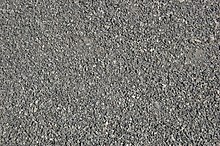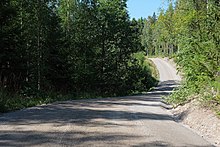Gravel

In geology and construction, sedimentary deposits formed by clasts between 2 and 64 millimeters in size are called gravel. They can be produced by humans, in which case it is usually called "broken stone", or the result of natural processes. In this case, in addition, it usually happens that the natural wear produced by the movement in the river beds has generated rounded shapes, in which case it is known as boulder. There are also cases of natural gravel that are not pebbles.
These aggregates are granular particles of stone material (i.e. stones) of variable size. This material originates from the fragmentation of the different rocks of the Earth's crust, whether naturally or artificially. In the latter case, the crushing or crushing processes used in the respective aggregate plants operate. The material that is processed corresponds mainly to limestone, granite, dolomite, basalt, sandstone, quartz and quartzite rocks.
Conglomerates are sedimentary rocks formed by the diagenesis of gravel (compaction, recrystallization or cementation).
Gravel is classified by particle size and includes size classes from granular to cobble-sized fragments. On the Udden-Wentworth scale, gravel is classified as granular gravel (0.1-0.2 inch) and pebble gravel (0.2-2.5 inch). The ISO 14688 standard classifies gravels into fine, medium and coarse, with ranges from 2–6.3 mm to 20–63 mm. A cubic meter of gravel typically weighs about 1,800 kg (or a cubic yard weighs about 3,000 pounds).
Gravel is an important commercial product, with numerous applications. Almost half of all gravel production is used as aggregate for concrete. Much of the remainder is used for road construction, either in the road base or as pavement (with or without asphalt or other binders.) Naturally porous gravel deposits have high hydraulic conductivity, making them important aquifers.
Origin
Most gravel comes from the disintegration of parent rock as it weathers and erodes. Quartz and quartzite are the most common components of gravels. Quartz is a common hard mineral, chemically inert, and lacks cleavage planes along which the mineral could easily cleave. Quartzite, for its part, is a very hard and compact rock, which resists abrasion during transportation better than others. Most gravel particles are made up of rock fragments (which are themselves composed of aggregates of mineral grains), as few parent rocks have mineral grains coarser than about 8 millimeters (0.3 in). Exceptions are quartz veins and veins, pegmatites, deep intrusions, high-grade metamorphic rocks or basalts. Rock fragments round rapidly as they are transported by rivers, often within a few dozen kilometers of their original outcrops.
Gravel is deposited as gravel beds or bars in stream channels; in alluvial fans; in nearshore marine environments, where gravel is supplied by streams or erosion along from the coast; of the basin.
It has been suggested that the gravel megaripples formed by the wind in Argentina have counterparts on the planet Mars.
Etymology
The word gravel comes from the Old French gravele or gravelle.
Definition and properties

Colloquially, the term gravel is often used to describe a mixture of pieces of stone of different sizes mixed with sand and possibly some clay. The American construction industry distinguishes between gravel (a natural material) and crushed stone. (artificially produced by mechanical crushing of rock).
The technical definition of gravel varies depending on the region and the scope of application. Many geologists define gravel simply as loose, rounded rock particles larger than 2 millimeters (0.1 in) in diameter, without specifying an upper size limit. Gravel is sometimes distinguished from rubble, which are loose rock particles of the same size but angular in shape. The Udden-Wentworth scale, widely used by geologists in the US, defines granular gravel as particles with a size of 2 to 4 millimeters (0.1 to 0.2 in) and pebble gravel as particles with a size of 4 to 64 millimeters (0.2 to 2.5 in). This corresponds to all particles with sizes between coarse sand and pebbles.
The U.S. Department of Agriculture and the Soil Science Society of America define gravel as particles of 2 to 80 millimeters (0.1 to 3.1 in) in size, while the German (Atterburg) scale defines gravel as particles of 2 to 200 millimeters. (0.1 to 7.9 in) size. The United States Army Corps of Engineers defines gravel as particles smaller than 3 in (76.2 mm) in size that are retained by a number 4 mesh, which has a mesh spacing of 4.76 millimeters (0.2 in). ISO 14688 for soil engineering classifies gravels into fine, medium and coarse with ranges from 2 mm to 6.3 mm to 20 mm to 63 mm..
The apparent density of gravel varies between 1,460 and 1,920 kilograms per cubic meter (2,460.9 and 3,236.3 lb/yd³). Natural gravel has a high hydraulic conductivity, sometimes exceeding 1 cm/s.
Granulometry
| Particle | Size |
|---|---|
| Clays | . 0.0039 mm |
| Limos | 0.0039-0,0625 mm |
| Arenas | 0.0625-2 mm |
| Gravas | 2-64 mm |
| Rod songs | 64-256 mm |
| Blocks | 256 mm |
Types


.
Types of gravel include:
- Grava de ribera
- gravel deposited naturally intermingled with sand or clay found in rivers and streams and next to them. It is also known as "bank run" or "river run".
- Grava de bench
- gravel bed located on the slope of a valley above the current bottom of the stream, which indicates the old location of the creek bed when it was at a higher level. The term is most commonly used in Alaska and the Yukon Territory.
- Crushed stone
- crushed and classified rock through cribes and then mixed to obtain a mixture of stones and fine. It is used much as road and road covering, sometimes with tar applied on top. The crushed stone can be made of granite, limestone, dolomite and other rocks. It is also known as "crusher run", DGA (dense grade), QP (quarry process) and shoulder stone. The United States Geological Service distinguishes the crushed stone from the gravel.
- Fine Grava
- gravel formed by particles with a diameter of 2 to 6.3 millimeters (0.1 to 0.2 plg)
- Stone dust
- fine, crushed gravel, coming from the final phase of the separation by chryba, so that the gravel is not separated from thin dust particles. Like other forms of crushed stone, the United States Geological Service distinguishes it from gravel.
- Lag gravel
- thick surface accumulation of gravel produced by the elimination of thinner particles.
- Pay gravel
- also known as "pay dirt"; a nickname for gravel with a high concentration of gold and other precious metals. Metals are recovered by gold washing.
- Grava of peas
- also known as "guisant gravel" is a clean gravel similar in size to garden peas.. It is used for concrete surfaces, walkways, and as a substrate in domestic aquariums.
- Grava de piedemonte
- a thick gravel dragged from high places by mountain streams and deposited on relatively flat terrain, where the water runs slower.
- Grava de meseta
- a layer of gravel in a plateau or another region above the height to which the gravel of terraces of streams is usually found.
Production and uses


Gravel is an important basic raw material in construction, it is used as aggregate in the manufacture of concrete. Also, as ballast and protective coating on non-trafficable flat roofs, and as a filter in slabs and drains. Sand is not usually distinguished from gravel in official statistics, but crushed stone is treated as a separate category. In 2020, sand and gravel together accounted for 23% of all industrial mineral production in the United States, with a total value of about $12.6 billion. About 960 million tons of sand and gravel were produced for construction. This figure far exceeds the production of industrial sand and gravel (68 million tons), which is mainly sand and not gravel.
It is estimated that almost half of construction sand and gravel is used as aggregate for concrete. Other important uses are in road construction, as a road base or in asphalt; as construction filler; and in countless minor uses.
Gravel is widely and abundantly distributed, primarily in the form of fluvial deposits, river floodplains, and glacial deposits, so environmental considerations and quality dictate whether alternatives, such as crushed stone, are suitable. more economical. Crushed stone is already displacing natural gravel in the eastern United States, and recycled gravel is also increasingly important.
Obtaining
As a source of supply, the following situations can be distinguished:
- Sedimentation banks: are artificially built banks to embed the fine-grey material that drag the rivers.
- River flow: it corresponds to the extraction from the riverbed, where material is carried away by the draining of the waters.
- Dry wells: areas of ancient alluvial fillers in valleys close to rivers.
- quarries: it is the exploitation of rocky blankets or geological formations, where the materials are usually extracted from hills by what is called thronadura or blast (red by explosives).
Contenido relacionado
Gemology
Hydrology
Sial
Earth mantle
Olivine